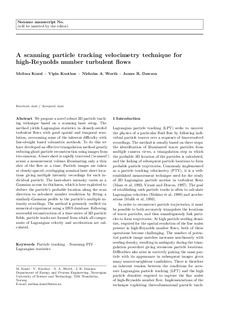A scanning particle tracking velocimetry technique for high‑Reynolds number turbulent flows
Journal article, Peer reviewed
Accepted version

View/
Date
2019Metadata
Show full item recordCollections
Abstract
We propose a novel robust 3D particle tracking technique based on a scanning laser setup. The method yields Lagrangian statistics in densely seeded turbulent flows with good spatial and temporal resolution, overcoming some of the inherent difficulty with line-of-sight-based volumetric methods. To do this, we have developed an effective triangulation method greatly reducing ghost particle reconstruction using images from two cameras. A laser sheet is rapidly traversed (‘scanned’) across a measurement volume illuminating only a thin slice of the flow at a time. Particle images are taken at closely spaced, overlapping nominal laser sheet locations giving multiple intensity recordings for each individual particle. The laser-sheet intensity varies as a Gaussian across its thickness, which is here exploited to deduce the particle’s probable location along the scan direction to sub-sheet number resolution by fitting a similar Gaussian profile to the particle’s multiple intensity recordings. The method is presently verified via numerical experiment using a DNS database. Following successful reconstruction of a time series of 3D particle fields, particle tracks are formed from which all components of Lagrangian velocity and acceleration are calculated.